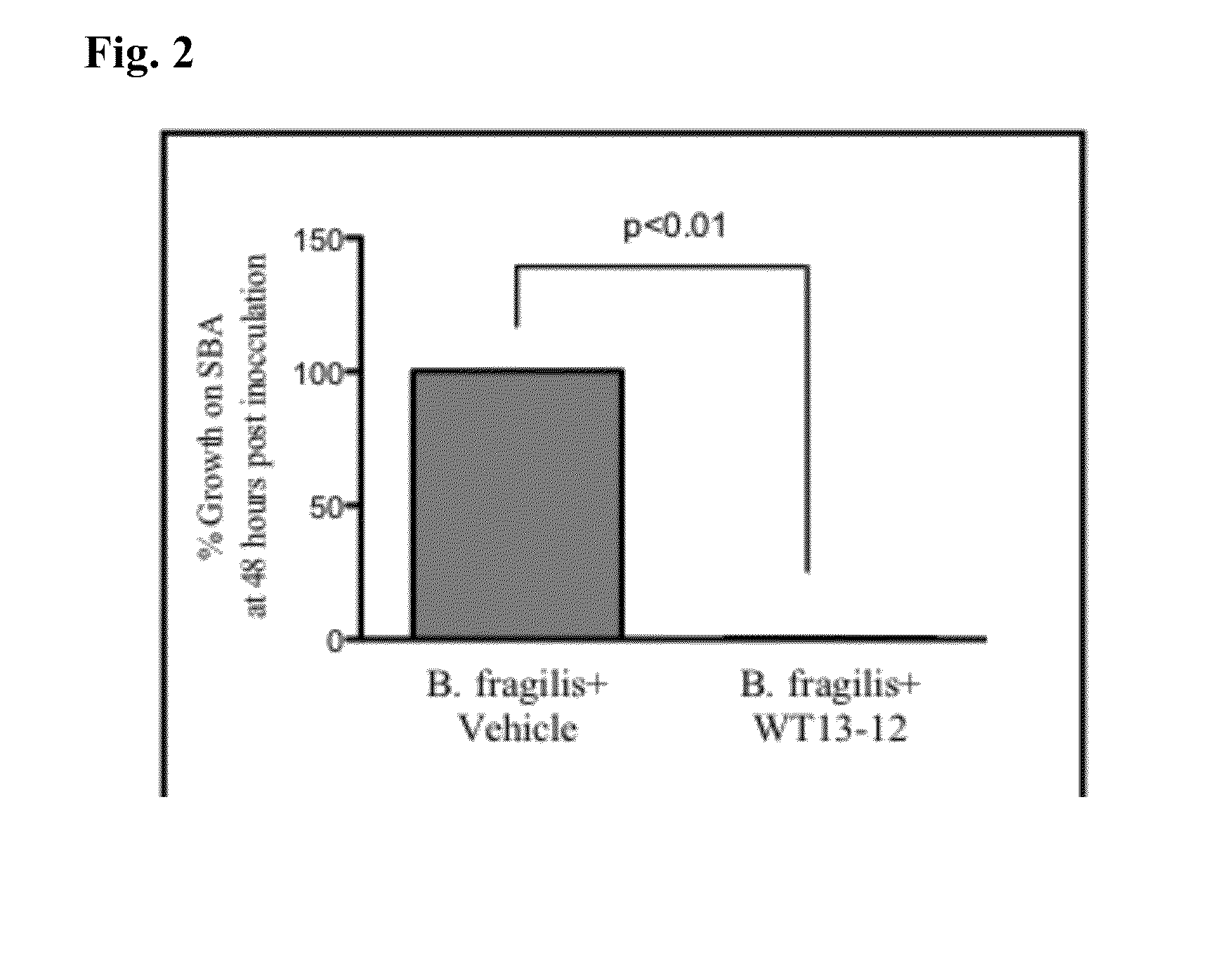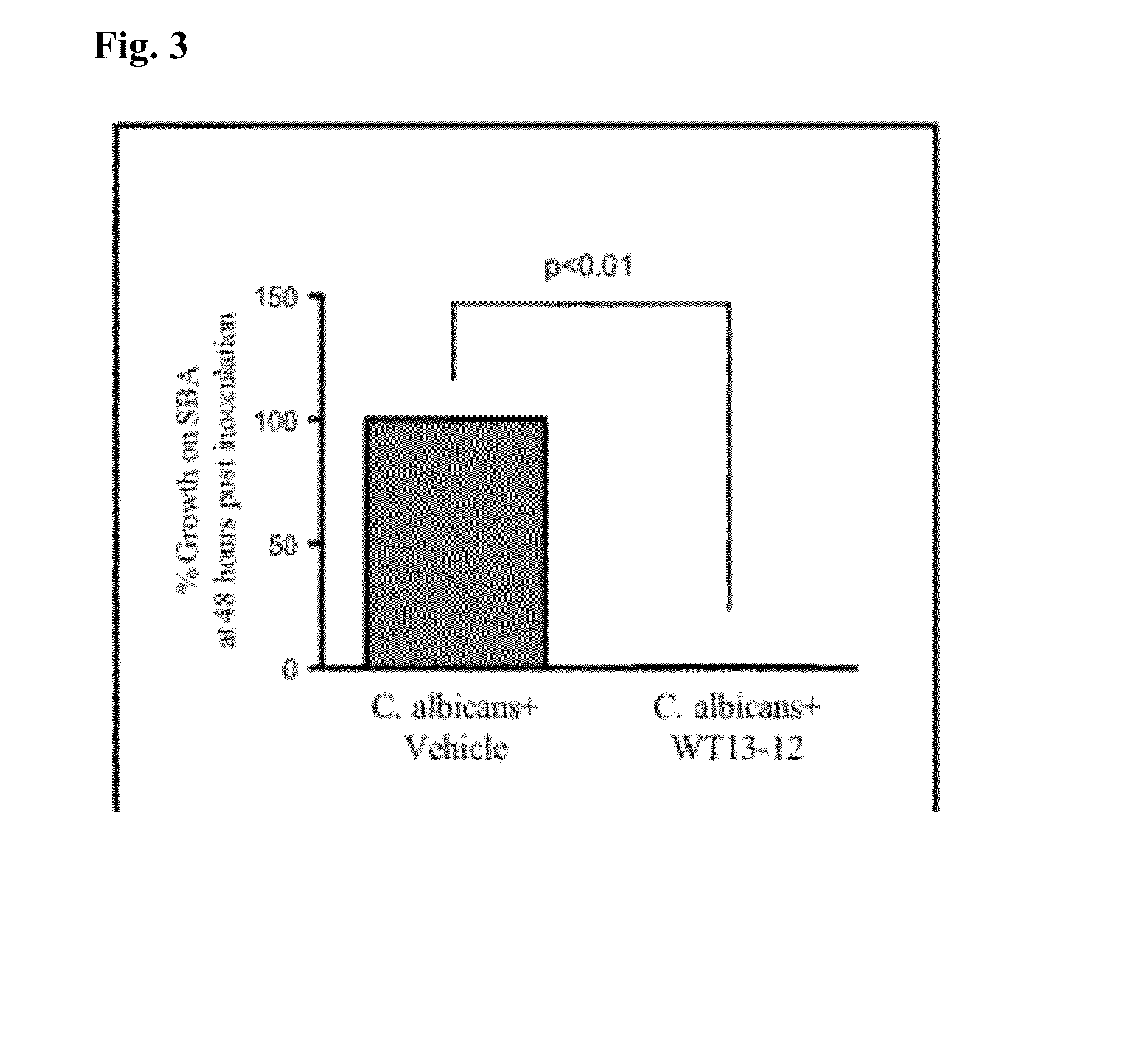Therapeutic Compounds
a technology of therapeutic compounds and compounds, applied in the field of therapeutic compounds, can solve the problems of serious health care problems, septicemia and death, and bacterial infections of the skin and underlying tissue present significant clinical treatment problems, and achieve the effects of reducing the amount of dead tissue, and improving the cleanliness of wounds
- Summary
- Abstract
- Description
- Claims
- Application Information
AI Technical Summary
Benefits of technology
Problems solved by technology
Method used
Image
Examples
example 1
Compound Preparation (WT13-12)
[0106]A combination therapy of the invention that includes 50% w / v L-Arginine, 20% v / v undecylenic acid, and 0.25% w / v Rheum Officinale extract was prepared for in vitro and in vivo testing. In one embodiment, the combination therapy further contains 1% Menthol by volume (extract 1 mL of solution and add 0.890 g of Menthol).
To Prepare 200 mL of WT13-12:
[0107]1. Aliquot 200 mL of distilled water into a beaker that is on a hot plate.
2. Heat the water to 65° C. and mix with a magnetic stirbar.
3. Add 100 g of L-Arginine to the water slowly until it is all dissolved.
4. Prepare 40 mL of undecylenic acid and 4 g of CreamMaker CA-20 in a separate beaker.
5. Aliquot 200 mL of the L-Arginine solution into a new beaker and add 0.5 g of Rheum Officinale. Maintain at 65° C. while spinning
6. Aliquot 160 mL of the L-Arginine / Rheum Officinale Solution into the beaker containing 40 mL of undecylenic acid and 4 g of CreamMaker CA-20.
7. Spin and heat the new solution betwe...
example 2
Broad In-Vitro Bacterial Growth Inhibition
[0109]In vitro testing was conducted to measure the efficacy of WT13-12 at inhibiting the growth of clinically relevant bacteria. WT13-12 consists of 500 mg / mL L-arginine, 20% v / v undecylenic acid, and 0.25% w / v Rheum Officinale. WT13-12 was streaked across half of a sheep blood agar (SBA) plate and allowed to dry for 15 minutes. The other side was streaked with the vehicle but not containing WT13-12. After drying, 50 μL of purified bacteria at 100,000 col / mL was streaked onto the control and treated sides of the sheep blood agar plates. After streaking, the plates were incubated at 37° C. for 48 hours. Growth was assessed at 24 and 48 hours post-inoculation. Percent inhibition was determined by measuring the treated side vs. the control side with the control side set at 100% growth. Plates were also compared to control plates that were not streaked with the vehicle to ensure the vehicle did not inhibit growth of the microorganisms (vehicle ...
example 3
In Vitro Combination Assays Reveal Synergistic Mechanism of Action
[0111]Each component of WT13-12 was tested individually or in paired combination in the in vitro bacterial growth inhibition assay described above to determine the relative contribution of each component. As shown in FIGS. 4-7, no individual component (i.e., L-Arginine, undecylenic acid, or Rheum Officinale extract) or paired combination of components produced any significant inhibition of MRSA, S. agalactiae, S. pyogenes, or E. faecalis within twenty-four hours following culture inoculation whereas the triple combination WT13-12 restricted culture growth in a statistically significant manner. These results indicate the combination therapy WT13-12 is based on the synergistic mechanism of biological action of its three components and is not simply the result of additive inhibition by the constitutive molecules of the combination therapy.
PUM
| Property | Measurement | Unit |
|---|---|---|
| time | aaaaa | aaaaa |
| volume | aaaaa | aaaaa |
| diameter | aaaaa | aaaaa |
Abstract
Description
Claims
Application Information
 Login to View More
Login to View More - R&D
- Intellectual Property
- Life Sciences
- Materials
- Tech Scout
- Unparalleled Data Quality
- Higher Quality Content
- 60% Fewer Hallucinations
Browse by: Latest US Patents, China's latest patents, Technical Efficacy Thesaurus, Application Domain, Technology Topic, Popular Technical Reports.
© 2025 PatSnap. All rights reserved.Legal|Privacy policy|Modern Slavery Act Transparency Statement|Sitemap|About US| Contact US: help@patsnap.com



